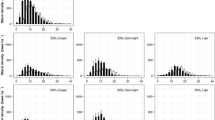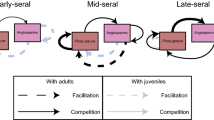Summary
Data from forestry yield tables were used to investigate the population structure of natural stands of Atlantic White Cedar (Chamaecyparis thyoides) in the mid-Atlantic states. The proportion of individuals in three size classes, 1–5 inch dbh, 5–8 inch dbh and > 8 inch dbh was shown to depend on both site age since clearcutting and site quality. Site age and site quality also determined the degree to which cedar populations underwent density dependent mortality (self-thinning). On all sites, the smallest individuals were removed by self-thinning. Analyses of this type allow predictions to be made of forest stand dynamics and further an understanding of population processes in natural communities.
Similar content being viewed by others
References
Bamford GT, Little S (1960) Effects of low thinning in Atlantic White-Cedar swamps. Forest Research Notes 104:1–4, NE For Expt Sta, USDA For Serv, Upper Darby, Pa
Cheyney EG (1942) American Silvics and Silviculture. University of Minnesota Press, Minneapolis
Cottrell AT (1930) Thinning white cedar in New Jersey. J For 28:1157–1162
Drew TJ, Flewelling F (1977) Some recent Japanese theories of yield-density relationships and their application to Monterey pine plantations. For Sci 23:517–534
Ehrenfeld JG, Schneider JP (1983) The sensitivity of cedar swamps to the effects of non-point source pollution associated with suburbanization in the New Jersey Pine Barrens. Center for Coastal and Environmental Studies, Rutgers University, New Brunswick, NJ
Gorham E (1979) Shoot height, weight and standing crop in relation to density of monospecific plant stands. Nature 279:148–150
Harding RB, Grigal DF, White EH (1985) Site quality evaluation for white spruce populations using discriminant analysis. Soil Sci Soc Amer Journal 49:229–232
Harms WR, Langdon OG (1976) Development of loblolly pine in dense stands. For Sci 22:331–337
Husch B, Miller CI, Beers TW (1972) Forest Mensuration (2nd Edit) Ronald Press Co., New York
Jefferies RL, Davy AJ, Rudnik T (1981) Population biology of the salt marsh annual Salicornia europaea agg. J Ecol 69:17–31
Korstian CF, Brush WD (1931) Southern White Cedar USDA Technical Bulletin No 251
Lee Y (1971) Predicting mortality for even-aged stands of lodgepole pine. For Chron 47:29–32
Little E (1971) Atlas of United States Trees, vol 1. USDA Misc Publ No 1146
Little S (1950) Ecology and silviculture of whitecedar and associated hardwoods in southern New Jersey. School of Forestry Bull No 56 Yale University
Lonsdale WM, Watkinson AR (1982) Light and self-thinning. New Phytol 90:431–445
Lonsdale WM, Watkinson AR (1983) Plant geometry and selfthinning. J Ecol 71:285–297
McCormick J (1979) The vegetation of the New Jersey Pine Barrens. In: Forman RTT (ed.) Pine Barrens: ecosystem and landscape. Academic Press, New York
Moore EB, Waldron AF (1940) Growth studies of southern white cedar in New Jersey. J For 38:568–572
Parnell JAN (1985) Biological flora of the British Isles, No 157: Jasione montana L. J Ecol 73:341–358
Phillips JJ, Markley ML (1963) Site index of New Jersey sweetgum stands related to soil and water-table characteristics. US For Serv Res Paper NE-6
Tadaki Y (1963) The pre-estimating of stem yield based on the competition-density effect. Bull Govt For Expt Stn Japan No 154:1–19
Tadaki Y (1964) Effect of thinning on stem volume yield studied with competition-density effect. Bull Govt For Expt Stn Japan No 156:1–22
Tourney NB, Tourney JW, Korstian CF (1937) Foundations of Silviculture upon an Ecological Basis (2nd Edit). John Wiley & Sons, Inc, New York
Watkinson AR, Harper JL (1978) The demography of the sand dune annual Vulpia fasiculata. 1. The natural regulation of populations. J Ecol 66:15–33
Westoby M (1984) The self-thinning rule. Adv Ecol Res 14:167–225
Westoby M, Howell J (1981) Self-thinning: the effect of shading on glasshouse populations of silver beet (Beta vulgaris). J Ecol 69:359–365
White J (1980) Demographic factors in populations of plants. In: OT Solbrig (ed) Demography and evolution in plant populations. Univ California Press, Berkeley & Los Angeles
White J (1981) The allometric interpretation of the self-thinning rule. J Theoretical Biol 89:475–500
White J, Harper JL (1970) Correlated changes in plant size and number in plant populations. J Ecol 279:148–150
Yoda K, Kira T, Ogawa H, Hozumi K (1963) Intraspecific competition among higher plants. XI. Self-thinning in over-crowded pure stands under cultivated and natural conditions. J Biol Osaka City Univ 14:107–129
Author information
Authors and Affiliations
Rights and permissions
About this article
Cite this article
Gibson, D.J., Good, R.E. Population structure and thinning in natural stands of Atlantic White Cedar (Chamaecyparis thyoides (L.) BSP). Oecologia 69, 348–353 (1986). https://doi.org/10.1007/BF00377055
Received:
Issue Date:
DOI: https://doi.org/10.1007/BF00377055




